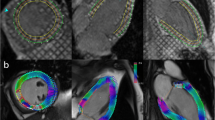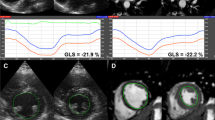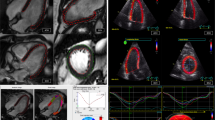Abstract
Objectives
To evaluate deformable registration algorithms (DRA)-based quantification of cine steady-state free-precession (SSFP) for myocardial strain assessment in comparison with feature-tracking (FT) and speckle-tracking echocardiography (STE).
Methods
Data sets of 28 patients/10 volunteers, undergoing same-day 1.5T cardiac MRI and echocardiography were included. LV global longitudinal (GLS), circumferential (GCS) and radial (GRS) peak systolic strain were assessed on cine SSFP data using commercially available FT algorithms and prototype DRA-based algorithms. STE was applied as standard of reference for accuracy, precision and intra-/interobserver reproducibility testing.
Results
DRA showed narrower limits of agreement compared to STE for GLS (-4.0 [-0.9,-7.9]) and GCS (-5.1 [1.1,-11.2]) than FT (3.2 [11.2,-4.9]; 3.8 [13.9,-6.3], respectively). While both DRA and FT demonstrated significant differences to STE for GLS and GCS (all p<0.001), only DRA correlated significantly to STE for GLS (r=0.47; p=0.006). However, good correlation was demonstrated between MR techniques (GLS:r=0.74; GCS:r=0.80; GRS:r=0.45, all p<0.05). Comparing DRA with FT, intra-/interobserver coefficient of variance was lower (1.6 %/3.2 % vs. 6.4 %/5.7 %) and intraclass-correlation coefficient was higher. DRA GCS and GRS data presented zero variability for repeated observations.
Conclusions
DRA is an automated method that allows myocardial deformation assessment with superior reproducibility compared to FT.
Key Points
• Inverse deformable registration algorithms (DRA) allow myocardial strain analysis on cine MRI.
• Inverse DRA demonstrated superior reproducibility compared to feature-tracking (FT) methods.
• Cine MR DRA and FT analysis demonstrate differences to speckle-tracking echocardiography
• DRA demonstrated better correlation with STE than FT for MR-derived global strain data.








Similar content being viewed by others
References
Pagidipati NJ, Gaziano TA (2013) Estimating deaths from cardiovascular disease: a review of global methodologies of mortality measurement. Circulation 127:749–756
McMurray JJ, Pfeffer MA (2005) Heart failure. Lancet 365:1877–1889
Lloyd-Jones DM, Larson MG, Leip EP et al (2002) Lifetime risk for developing congestive heart failure: the Framingham Heart Study. Circulation 106:3068–3072
Varadarajan P, Pai RG (2003) Prognosis of congestive heart failure in patients with normal versus reduced ejection fractions: results from a cohort of 2,258 hospitalized patients. J Card Fail 9:107–112
Solomon SD, Anavekar N, Skali H et al (2005) Influence of ejection fraction on cardiovascular outcomes in a broad spectrum of heart failure patients. Circulation 112:3738–3744
Pattynama PM, De Roos A, Van der Wall EE, Van Voorthuisen AE (1994) Evaluation of cardiac function with magnetic resonance imaging. Am Heart J 128:595–607
Sanderson JE (2007) Heart failure with a normal ejection fraction. Heart 93:155–158
Sjoli B, Orn S, Grenne B et al (2009) Comparison of left ventricular ejection fraction and left ventricular global strain as determinants of infarct size in patients with acute myocardial infarction. J Am Soc Echocardiogr 22:1232–1238
Smedsrud MK, Pettersen E, Gjesdal O et al (2011) Detection of left ventricular dysfunction by global longitudinal systolic strain in patients with chronic aortic regurgitation. J Am Soc Echocardiogr 24:1253–1259
Shehata ML, Cheng S, Osman NF, Bluemke DA, Lima JA (2009) Myocardial tissue tagging with cardiovascular magnetic resonance. J Cardiovasc Magn Reson 11:55
Zerhouni EA, Parish DM, Rogers WJ, Yang A, Shapiro EP (1988) Human heart: tagging with MR imaging--a method for noninvasive assessment of myocardial motion. Radiology 169:59–63
Young AA, Axel L, Dougherty L, Bogen DK, Parenteau CS (1993) Validation of tagging with MR imaging to estimate material deformation. Radiology 188:101–108
Yeon SB, Reichek N, Tallant BA et al (2001) Validation of in vivo myocardial strain measurement by magnetic resonance tagging with sonomicrometry. J Am Coll Cardiol 38:555–561
Jiang K, Yu X (2014) Quantification of regional myocardial wall motion by cardiovascular magnetic resonance. Quant Imaging Med Surg 4:345–357
Osman NF, Kerwin WS, McVeigh ER, Prince JL (1999) Cardiac motion tracking using CINE harmonic phase (HARP) magnetic resonance imaging. Magn Reson Med 42:1048–1060
Kuijer JP, Hofman MB, Zwanenburg JJ, Marcus JT, van Rossum AC, Heethaar RM (2006) DENSE and HARP: two views on the same technique of phase-based strain imaging. J Magn Reson Imaging 24:1432–1438
Onishi T, Saha SK, Ludwig DR et al (2013) Feature tracking measurement of dyssynchrony from cardiovascular magnetic resonance cine acquisitions: comparison with echocardiographic speckle tracking. J Cardiovasc Magn Reson 15:95
Kempny A, Fernandez-Jimenez R, Orwat S et al (2012) Quantification of biventricular myocardial function using cardiac magnetic resonance feature tracking, endocardial border delineation and echocardiographic speckle tracking in patients with repaired tetralogy of Fallot and healthy controls. J Cardiovasc Magn Reson 14:32
Hor KN, Baumann R, Pedrizzetti G et al (2011) Magnetic resonance derived myocardial strain assessment using feature tracking. J Vis Exp. doi:10.3791/2356
Collins JD (2015) Global and regional functional assessment of ischemic heart disease with cardiac MR imaging. Radiol Clin N Am 53:369–395
Onishi T, Saha SK, Delgado-Montero A et al (2015) Global longitudinal strain and global circumferential strain by speckle-tracking echocardiography and feature-tracking cardiac magnetic resonance imaging: comparison with left ventricular ejection fraction. J Am Soc Echocardiogr 28:587–596
Piehler KM, Wong TC, Puntil KS et al (2013) Free-breathing, motion-corrected late gadolinium enhancement is robust and extends risk stratification to vulnerable patients. Circ Cardiovasc Imaging 6:423–432
Ge L, Kino A, Griswold M, Carr JC, Li D (2010) Free-breathing myocardial perfusion MRI using SW-CG-HYPR and motion correction. Magn Reson Med 64:1148–1154
Doesch C, Papavassiliu T, Michaely HJ et al (2013) Detection of myocardial ischemia by automated, motion-corrected, color-encoded perfusion maps compared with visual analysis of adenosine stress cardiovascular magnetic resonance imaging at 3 T: a pilot study. Investig Radiol 48:678–686
Jolly MP, Guetter C, Lu X, Xue H, Guehring J (2011) Automatic segmentation of the myocardium in cine MR images using deformable registration. Proc Workshop Statistical Atlases and Computational Models of the Heart: Imaging and Modelling Challenges, Toronto, ON
Jolly MP, Guetter C, Guehring J (2010) Cardiac segmentation in MR cine data using inverse consistent deformable registrationInternational Symposium of Biomedical Imaging: From Nano to Macro, Rotterdam, pp 484–487
Guetter C, Xue H, Chefd’hotel C, Guehring J (2011) Efficient symmetric and inverseconsistent deformable registration through interleaved optimization. IEEE International Symposium on Biomedical Imaging: from nano to macro, Chicago, IL, pp 590–593
Hanneman K, Nguyen ET, Thavendiranathan P et al (2016) Quantification of myocardial extracellular volume fraction with cardiac MR imaging in thalassemia major. Radiology 279:720–730
Lang RM, Badano LP, Mor-Avi V et al (2015) Recommendations for cardiac chamber quantification by echocardiography in adults: an update from the American Society of Echocardiography and the European Association of Cardiovascular Imaging. J Am Soc Echocardiogr 28(1-39):e14
Jolly MP, Guetter C, Lu X, Xue H, Guehring J (2011) Automatic segmentation of the myocardium in cine MR images using deformable registration.Proc Workshop Statistical Atlases and Computational Models of the Heart: Imaging and Modelling Challenges, Toronto, ON, pp 98–108
Epstein FH (2007) MRI of left ventricular function. J Nucl Cardiol 14:729–744
Pedrizzetti G, Mangual J, Tonti G (2014) On the geometrical relationship between global longitudinal strain and ejection fraction in the evaluation of cardiac contraction. J Biomech 47:746–749
Sun JP, Stewart WJ, Yang XS et al (2009) Differentiation of hypertrophic cardiomyopathy and cardiac amyloidosis from other causes of ventricular wall thickening by two-dimensional strain imaging echocardiography. Am J Cardiol 103:411–415
Kempny A, Diller GP, Kaleschke G et al (2013) Longitudinal left ventricular 2D strain is superior to ejection fraction in predicting myocardial recovery and symptomatic improvement after aortic valve implantation. Int J Cardiol 167:2239–2243
Yingchoncharoen T, Agarwal S, Popovic ZB, Marwick TH (2013) Normal ranges of left ventricular strain: a meta-analysis. J Am Soc Echocardiogr 26:185–191
Marwick TH, Leano RL, Brown J et al (2009) Myocardial strain measurement with 2-dimensional speckle-tracking echocardiography: definition of normal range. JACC Cardiovasc Imaging 2:80–84
Moody WE, Taylor RJ, Edwards NC et al (2015) Comparison of magnetic resonance feature tracking for systolic and diastolic strain and strain rate calculation with spatial modulation of magnetization imaging analysis. J Magn Reson Imaging 41:1000–1012
Augustine D, Lewandowski AJ, Lazdam M et al (2013) Global and regional left ventricular myocardial deformation measures by magnetic resonance feature tracking in healthy volunteers: comparison with tagging and relevance of gender. J Cardiovasc Magn Reson 15:8
Claus P, Omar AM, Pedrizzetti G, Sengupta PP, Nagel E (2015) Tissue tracking technology for assessing cardiac mechanics: principles, normal values, and clinical applications. JACC Cardiovasc Imaging 8:1444–1460
Orwat S, Kempny A, Diller GP et al (2014) Cardiac magnetic resonance feature tracking: a novel method to assess myocardial strain. Comparison with echocardiographic speckle tracking in healthy volunteers and in patients with left ventricular hypertrophy. Kardiol Pol 72:363–371
Schmidt R, Orwat S, Kempny A et al (2014) Value of speckle-tracking echocardiography and MRI-based feature tracking analysis in adult patients after Fontan-type palliation. Congenit Heart Dis 9:397–406
Amundsen BH, Crosby J, Steen PA, Torp H, Slordahl SA, Stoylen A (2009) Regional myocardial long-axis strain and strain rate measured by different tissue Doppler and speckle tracking echocardiography methods: a comparison with tagged magnetic resonance imaging. Eur J Echocardiogr 10:229–237
Amundsen BH, Helle-Valle T, Edvardsen T et al (2006) Noninvasive myocardial strain measurement by speckle tracking echocardiography: validation against sonomicrometry and tagged magnetic resonance imaging. J Am Coll Cardiol 47:789–793
Kleijn SA, Brouwer WP, Aly MF et al (2012) Comparison between three-dimensional speckle-tracking echocardiography and cardiac magnetic resonance imaging for quantification of left ventricular volumes and function. Eur Heart J Cardiovasc Imaging 13:834–839
Jeung MY, Germain P, Croisille P, El Ghannudi S, Roy C, Gangi A (2012) Myocardial tagging with MR imaging: overview of normal and pathologic findings. Radiographics 32:1381–1398
Donal E, Bergerot C, Thibault H et al (2009) Influence of after load on left ventricular radial and longitudinal systolic functions: a two-dimensional strain imaging study. Eur J Echocardiogr 10:914–921
Taylor RJ, Moody WE, Umar F et al (2015) Myocardial strain measurement with feature-tracking cardiovascular magnetic resonance: normal values. Eur Heart J Cardiovasc Imaging 16:871–881
Acknowledgments
Dr. Greiser and Dr. Jolly are employees of Siemens Healthcare GmbH (AG) and Siemens. Various parts of the results were presented at RSNA 2015 and the ESCR 2015.
Author information
Authors and Affiliations
Corresponding author
Ethics declarations
Conflict of interest
The scientific guarantor of this publication is Dr. Bernd J. Wintersperger, MD. The authors of this manuscript declare relationships with the following companies:
Bernd J. Wintersperger, Research support Siemens Healthcare
Bernd J. Wintersperger, Speakers Bureau & Honorarium Siemens Healthcare
Andreas Greiser, Employee Siemens Healthcare GmbH, Erlangen, Germany
Marie-Pierre Jolly, Employee Siemens Healthcare Medical Imaging Technologies, Princeton, NJ, USA
The authors state that this work has not received any funding. One of the authors has significant statistical expertise. Institutional Review Board approval was obtained. Written informed consent was obtained from all subjects (patients) in this study. Some study subjects or cohorts have been previously reported in Hanneman et al. published online in RADIOLOGY (entitled “Quantification of Myocardial Extracellular Volume Fraction with Cardiac MRI in Thalassemia Major”; however this study did not include any evaluation of regional all motion/strain analysis by MRI and had the sole focus of tissue level changes assessment). Methodology: retrospective, case-control study, performed at one institution.
Electronic supplementary material
Below is the link to the electronic supplementary material.
ESM 1
(DOCX 399 kb)
Rights and permissions
About this article
Cite this article
Lamacie, M.M., Thavendiranathan, P., Hanneman, K. et al. Quantification of global myocardial function by cine MRI deformable registration-based analysis: Comparison with MR feature tracking and speckle-tracking echocardiography. Eur Radiol 27, 1404–1415 (2017). https://doi.org/10.1007/s00330-016-4514-0
Received:
Revised:
Accepted:
Published:
Issue Date:
DOI: https://doi.org/10.1007/s00330-016-4514-0




